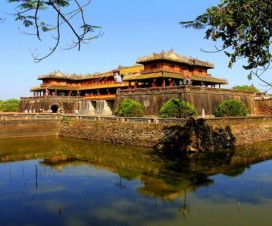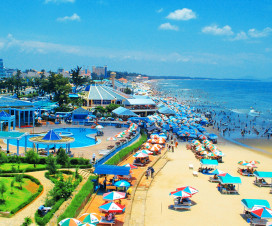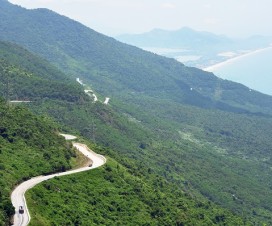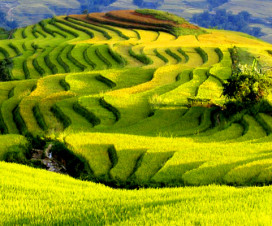After travelling from Hue to Hanoi we caught the overnight Green Train to Lao Cai in the mountains on the Chinese border. The train left Hanoi at 9.00 pm and we had a four berth compartment to ourselves. However, luxury was in short supply with shared loos and one washbasin for the carriage and it was a very rickety ride, making sleeping difficult. We arrived at Lao Cai at 5.30 am the following morning and were met by a guide who took us for a very early breakfast at a nearby restaurant. After breakfast we went to the bridge where one can cross over to China. The bridge is open from 7.00am to 7.00pm each day and we watched a steady stream of Vietnamese making their way over the bridge where apparently they purchase cheap Chinese goods which they then bring back to sell in Vietnam.
On the way to Sapa we stopped at a mountain town known as Bac Ha where, every Sunday, there is a large market to which all the surrounding villagers come to exchange goods and purchase their necessities. It could have been a rural scene in 18th century England, with almost everything for sale including cattle, pigs, hens, dogs, vegetables, ironwork and clothing, just to name a few. Of course, the piles of sugar beet and bamboo and the water buffalo that were being sold weren’t very Anglo Saxon.
Our hotel in Sapa had spectacular views of the town and the surrounding mountains, but very intermittently as most of the time it was surrounded by swirling mist. We experienced a drop in temperature and had to dig deep into our suitcases to find our warm clothes that we hadn’t worn since we left Totnes. We were thankful for the 3-bar electric fire in our bedroom and made sure that we reserved a table in the restaurant for dinner each night by the big log fire.
On our first full day John went off with Cuong, our guide, for a five hour hike in the mountains. The views through the mist showed terraces of paddy fields clinging to the slopes and there was water everywhere which made for a very muddy walk at times. It was almost like an oriental version of Wales! The packed lunch was eaten at the home of a Vietcong war veteran in one of the mountain villages.
Throughout the market at Bac Ha there are local women wearing a colourful traditional dress
built of wood with a corrugated iron roof, was very dark. It consisted of two rooms downstairs and two up which housed him, his family of eight and his scooter. On the walls were his certificates of commendation which he proudly showed off. Opposite his house was the village school which unfortunately was bereft of pupils as the locals feel it is more productive for their children to try and get money from the tourists than receive an education. Tourism is not necessarily helping these village people.
Lynne declined the opportunity of hiking and took the soft and restful option of a day at the hotel spa and pool to recover from the train ride!
On our second full day in Sapa the guide took us off for a drive to visit a couple of mountain villages. The houses are very basic being constructed of timber with corrugated iron or asbestos roofs and with very little home comforts inside. The homes also act as stores for the crops they have grown and houses their domestic animals such as hens together with their motorbikes. The floor is bare earth but clean and they have a very old TV in the middle of the house connected to a dish.
Just outside of Sapa the landscape is dominated by the watery terraces where shortly the annual rice crop is to be planted. What must they think when they see the conditions we live in on their televisions? No wonder so many of the local people devote their life to trying to extract money from the tourists. However the scenery surrounding the villages is a definite bonus and must provide some form of spiritual compensation.
At the end of the second full day it was back to Lao Cai to catch the 8.00 pm train back to Hanoi and arriving at 4.30 the following morning. Hanoi is the last lap of our journey.
by John from Totnes, The delights of Bangkok, Cambodia and Vietnam travelblog.org




